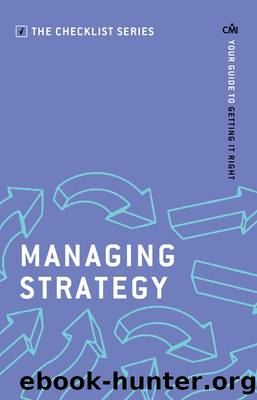Managing Strategy by Chartered Management Institute

Author:Chartered Management Institute
Language: eng
Format: epub
Publisher: Profile
Setting objectives
An objective is an end towards which effort is directed and resources are focused. Terminology varies and there is sometimes confusion over the use of terms such as objectives, aims, policy, goals and targets. It is important that everyone in an organisation understands the meaning of the terms used. The term ‘objective’ is used throughout this checklist.
This checklist is intended for managers who participate in setting corporate objectives, or who interpret and apply such objectives to their own functional or departmental areas of responsibility.
Setting corporate objectives involves clarifying the strategic aims and policy requirements of the organisation and agreeing related complementary operational objectives. This is an integrated process that links corporate planning or strategy-making to business operations and organisation structure. Objectives may be long-term and high-level or short-term and low-level. As objectives are cascaded through the organisation they usually become more specific, with clearly defined areas of application and time limits. Every department, unit, team and individual should have clear and meaningful objectives.
For objectives to be achieved successfully it is necessary to identify clear areas of responsibility, such as improving performance or service, and to prioritise objectives as essential or desirable. Write a statement of objectives that are SMART: specific, measurable, action-oriented, realistic, time- (and resource-) constrained. All objectives should be subject to a process of discussion and agreement with those members of staff responsible for their achievement. When staff members are involved in agreeing objectives, it is easier for them to take ownership of them and more likely to lead to commitment and successful achievement.
Be aware that if you fail to set objectives, you risk not knowing how or whether what you are doing fits in with your organisation’s longer-term plans or higher-level objectives. This can result in confusion and lowered morale, and it will be difficult to assess how successful you have been in managing personal, team or organisational performance.
Action checklist
1 Develop and communicate the organisation’s mission and vision
People often confuse mission and vision statements. It is possible, and even desirable, to have objectives relating to both.
The mission statement expresses the reason an organisation exists (e.g. to make top-quality cars) and provides an umbrella statement of its standing objectives. Typically this mission is enduring and changes little (unless the organisation undergoes radical re-engineering or a change of context).
The vision statement is an expression of the end result to which the organisation aspires. Typically, it provides guidance on timescale and measurable outcomes or indicators. For example: ‘Our aim is to become the largest-selling car manufacturer in the world by 2020.’ Such statements should be clearly communicated and reinforced with all employees, not just senior managers.
2 Identify corporate objectives from the mission/vision statements
It is important to link corporate objectives with mission and vision statements. This helps individuals see the importance, relevance and value of objectives and thus reinforces commitment to achieving them.
Formulating organisational strategy and objectives is normally the responsibility of senior management, but in empowered organisations this process may be delegated to other staff members. Some organisations use a bottom-up process to gauge achievability at the delivery level.
Download
This site does not store any files on its server. We only index and link to content provided by other sites. Please contact the content providers to delete copyright contents if any and email us, we'll remove relevant links or contents immediately.
Time Management Made Easy: How to Cultivate New Habits, Improve Productivity and Get Things Done by Joshua Strachan(2364)
The 7 Habits of Highly Effective People by Stephen R. Covey & Sean Covey(2095)
The Concise Laws of Human Nature by Robert Greene(1712)
Doesn't Hurt to Ask by Trey Gowdy(1555)
Primal Leadership by Daniel Goleman(1123)
Hook Point: How to Stand Out in a 3-Second World by Brendan Kane(1098)
HBR's 10 Must Reads 2021 by unknow(1044)
Don't Sweat the Small Stuff...and It's All Small Stuff by Richard Carlson(1012)
Amazon Unbound by Brad Stone(979)
100 Things Successful People Do by Nigel Cumberland(963)
HBR's 10 Must Reads 2021 by Harvard Business Review(955)
The Job Closer by Steve Dalton(935)
Master of One by Jordan Raynor(934)
Lives of the Stoics by Ryan Holiday & Stephen Hanselman(899)
Declutter Your Mind: A step by step guide to learn to control your thoughts, stop worrying, relieve anxiety and eliminate panic attacks and negative thinking by Mia Chandler(875)
The Power of 100! by Shaun King(841)
Conflicted by Ian Leslie(798)
Coders at Work: Reflections on the craft of programming by Peter Seibel(787)
The Book of Hope by Jane Goodall(743)
